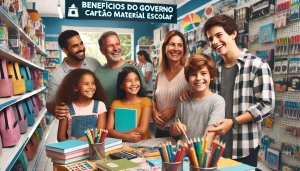Advertising
Bolsa Família is a direct cash transfer program created by the Brazilian government with the aim of reducing poverty and social inequality in the country. Established in 2003, the program seeks to guarantee access to basic rights such as food, education and health for vulnerable families.
Bolsa Família mainly serves families living in extreme poverty, with a per capita income below a certain limit set by the government.
As well as providing financial support, Bolsa Família promotes social inclusion by requiring counterparts, such as school attendance and keeping children's vaccination cards up to date. These requirements help to break the intergenerational cycle of poverty, encouraging human development and improving the living conditions of beneficiary families.
Over the years, the program has undergone several reformulations, but its main objectives have remained unchanged: to guarantee a social protection network for the poorest, to stimulate education and health, and to contribute to reducing inequality in Brazil.
Who is entitled to Bolsa Família: eligibility criteria
To be eligible for Bolsa Família, families must meet specific criteria set by the government. The main criterion is the family's per capita income. There are two main eligibility groups: families in extreme poverty, with a monthly per capita income of up to R$ 105.00, and families in poverty, with a monthly per capita income of between R$ 105.01 and R$ 210.00, provided they include pregnant women, children or teenagers.
In addition to income, the program takes into account family composition, prioritizing families with pregnant women, children and adolescents up to the age of 17. Another important point is that families must keep their registration information up to date, especially in relation to income and family composition, in order to continue receiving the benefit.
Advertising
In order to remain eligible, families must comply with the program's conditionalities, which include minimum school attendance of 85% for children and adolescents, and keeping vaccinations up to date, as well as prenatal care for pregnant women. Failure to comply with these conditions can result in the suspension or even cancellation of the benefit.
How to register for Bolsa Família: complete step-by-step process
The process of register The Bolsa Família application process is simple, but requires attention to detail to ensure that all the steps are followed correctly. The first step is to check that the family meets the eligibility criteria, as mentioned above. Next, the person responsible for the family should go to the nearest Social Assistance Reference Center (CRAS) or to their town hall.
At CRAS, the person responsible for the family will complete the Federal Government's Single Registry for Social Programs (CadÚnico), which is the main data collection tool for Bolsa Família. CadÚnico gathers socio-economic information on low-income families and serves as the basis for selecting beneficiaries. To register, you need to present personal documents for all family members, such as CPF, ID, birth or marriage certificates, a work permit and proof of residence.
After registering, the information is analyzed and, if approved, the family becomes part of the program and receives the monthly benefit. The amount of the benefit varies according to family composition and declared income. It is important to remember that the registration process is free and that the selection of beneficiaries is carried out by the government based on the data provided in CadÚnico.
Documentation required to register for Bolsa Família
To register It is essential that the person responsible for the family presents the correct and complete documents. The necessary documentation includes:
- Identification DocumentCPF, ID or other official document with photo.
- Proof of ResidenceElectricity bills, water bills or any other document that proves the family's current address.
- Birth or Marriage CertificateFor all family members, as applicable.
- Work permitFor family members who have.
- Voter registration: From the head of household.
In addition to these basic documents, it is important to bring all proof of income for each family member who works formally or informally. If there are children in the family, it is necessary to present their vaccination card and proof of school enrollment for children of school age.
These documents are essential for the government to be able to correctly assess the family's socio-economic situation and determine whether they are eligible to receive the benefit. Any inconsistency or lack of documentation can delay or prevent registration in the program, so it is important to check all the documents before going to CRAS.
How the Bolsa Família payment and calendar works
After register After being approved for the program, the family begins to receive the monthly benefit. Payment is made using the Bolsa Família card, which is issued by Caixa Econômica Federal. This card is sent to the registered address and must be used to withdraw the amounts at Caixa branches, lottery shops or Caixa Aqui correspondents.
The amount of the benefit varies according to income and family composition. There are basic benefits for families in extreme poverty, and variable benefits which are added according to the number of children, adolescents, pregnant women and nursing mothers in the family. There is also the Variable Benefit Linked to Adolescents (BVJ) for young people between the ages of 16 and 17 who are in school.
The payment schedule is based on the last digit of the Social Identification Number (NIS) printed on the card. Each month, the government publishes a calendar with the payment dates, and it is essential that beneficiaries pay attention so as not to miss the deadlines. The amounts are available for withdrawal for up to 90 days after the payment date.
How to check your Bolsa Família balance and information
To check the Bolsa Família balance and other information about the benefit, beneficiaries have several options. The simplest way is to use the Caixa Tem app or the specific Bolsa Família app, available for free download on Android and iOS devices. These apps allow you to check the balance, the payment schedule, the statement of the latest benefits and other important information.
Another way to check your balance is by calling Caixa's call center on 0800 726 0207. You will need to have your NIS number to get the information. In addition, the balance can also be consulted directly at Caixa self-service terminals, lottery shops or Caixa Aqui correspondents.
It is important for beneficiaries to keep their registration information up to date and to check the status of their benefit regularly to avoid surprises, such as having their payment blocked or canceled. Keeping your registration up to date is essential if you want to continue receiving Bolsa Família without interruption.
Recent updates and changes to Bolsa Família
In recent years, Bolsa Família has undergone some important updates and changes, aimed at improving the effectiveness of the program and adapting it to the new needs of the population. In 2021, for example, Auxílio Brasil was implemented, a program that integrated and replaced Bolsa Família, expanding the amounts paid and increasing the number of beneficiaries. However, Bolsa Família has returned to being the official name of the program, with adjustments and new criteria for distributing the benefits.
Recent changes include an increase in the value of the benefit and the inclusion of new modalities, such as the Early Childhood Benefit, aimed at families with children up to six years old, and the Compensatory Transition Benefit, to prevent families from losing the benefit abruptly.
The government has also stepped up monitoring to ensure that the funds go to those who really need them, avoiding fraud and embezzlement. The constant updates to the program aim to ensure that it continues to be an important instrument for fighting poverty and promoting social inclusion in Brazil.
Conclusion
Bolsa Família is one of Brazil's most important social programs, playing a crucial role in reducing poverty and promoting social inclusion. Understanding how the program works, who is eligible, and how to register are fundamental steps in ensuring that eligible families can take advantage of the benefits offered. With proper knowledge and compliance with the requirements, many families can significantly improve their quality of life through this important cash transfer program.



